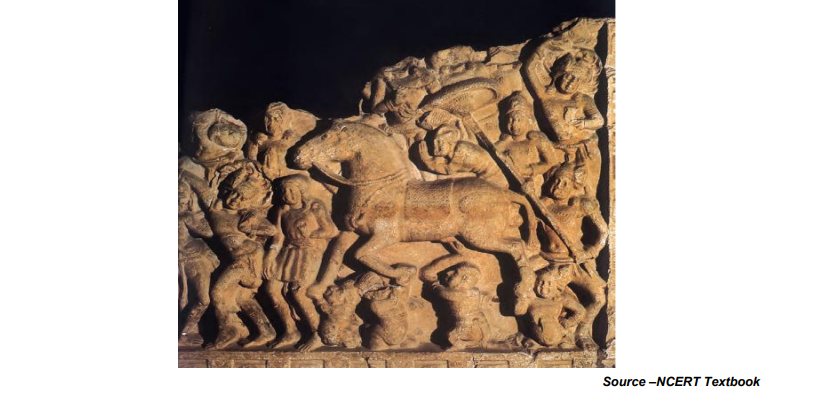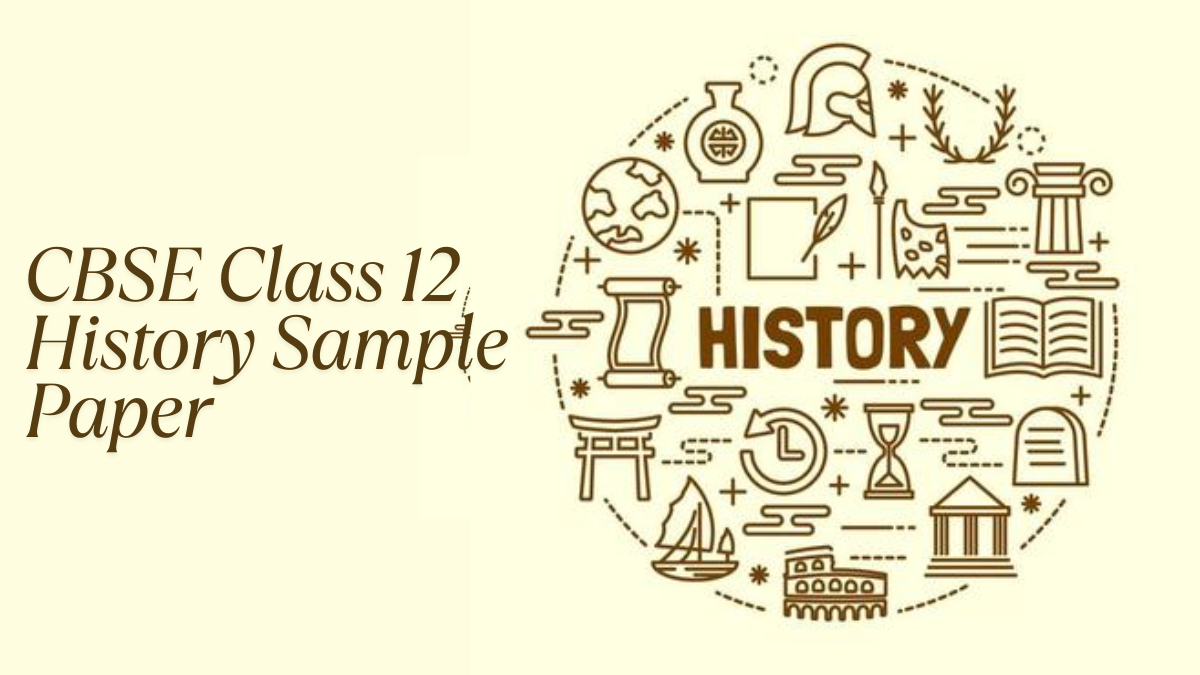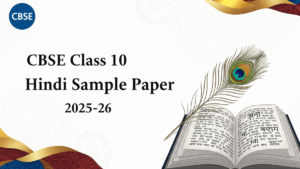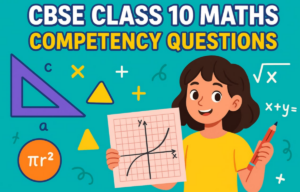History is one of the most crucial subjects for the class 12th Arts background students. The official CBSE Class 12 History Sample Paper 2025-26 PDF allows students to get familiar with the real exam paper pattern, question types, time management, and so on. Download CBSE Class 12 History Sample Paper 2025-26 with solutions, Free PDF, and enhance your board exam preparation.
CBSE Class 12 History Sample Paper 2025-26
The CBSE Class 12 History theory paper carries 80 points, with the remaining 20 points reserved for internal assessment. The 80-mark question paper is organised into five sections (A-E) and consists of 34 questions, comprising multiple-choice, short-answer, long-answer, source-based, and map work. Practicing the CBSE Class 12 History sample paper 2025-25 will assist students in becoming exam-ready and maximising their preparation.
CBSE Class 12th History Sample Paper 2025-26 PDF Download
Along with the Class 12 history sample paper 2025-26, the board has also provided the marking scheme, which indicates to students the answer writing approach. You may download both the documents from the official website of CBSE or from the table below in a hassle-free manner.
| History Class 12 Sample Paper Free PDF Download | |
| Class 12 history sample paper 2025-26 PDF | Download PDF |
| Marking scheme PDF | Download PDF |
Class 12th Physics Question paper Pattern
- The Class 12th Physics Question paper comprises five Sections – A, B, C, D and E. There are 34 questions in the question paper. All questions are compulsory.
- Section A – Question 1 to 21 are MCQs of 1 mark each.
- Section B – Question no. 22 to 27 are Short Answer Type Questions, carrying 3 marks each. Answers to each question should not exceed 60-80 words.
- Section C – Question no 28 to 30 are Long Answer Type Questions, carrying 8 marks each. Answer to each question should not exceed 300-350 words.
- Section D – Question no.31 to 33 are Source based questions with three sub questions and are of 4 marks each.
- Section-E – – Question no. 34 is Map based, carrying 5 marks that includes the identification and location of significant test items. Attach the map with the answer book.
- There is no overall choice in the question paper. However, an internal choice has been provided in a few questions. Only one of the choices in such questions have to be attempted.
- In addition to this, separate instructions are given with each section and question, wherever necessary.
History Class 12 Sample Paper 2025-26 with Solutions
SECTION A (1×21=21Marks)
OBJECTIVE TYPE QUESTIONS
1. Which of the following place of Harappan civilisation is associated with fire altars?
A. Harappa
B. Lothal
C. Mohenjodaro
D.Rakhigarhi
Answer: B. Lothal
2. Archaeologists have been able to reconstruct dietary practices from finds of charred grains and seeds. These are studied by __________.
A. Agronomist
B. Palaeontologist
C. Archaeo-botanists
D. Anthologist
Answer:C. Archaeo-botanists
3. Which one of the following is NOT a correct statement about Mahajanapadas?
A. Most mahajanapadas were ruled by kings.
B. Some known as ganas or sanghas, were oligarchies.
C. Each mahajanapada had a capital city, which was often fortified.
D. Panchala became the most powerful mahajanapada between 6-4 BCE.
Answer:D. Between the sixth and the fourth centuries BCE, Panchala became the most powerful mahajanapada.
4. Match the following and select the correct option

A. 1 – b, 2- c, 3 -d, 4- a
B. 1 – a, 2- d, 3 -c, 4- b
C. 1 – c, 2- b, 3 -d, 4- a
D. 1 – d, 2- a, 3 -b, 4- c
Answer:A. 1 – b, 2- c, 3 -d , 4- a
5. Which of the following states that the paternal estate was to be divided equally amongst sons after the death of the parents, with a special share for the eldest?
A. Vishnusmriti
B. Vyasasmriti
C. Likhitasmriti
D. Manusmriti
Answer:D. Manusmriti
6. Identify the given image from the following options.

Options:
A. A terracotta sculpture depicting a scene from the Mahabharata
B. A sculpture from Amaravati depicting Buddha leaving the palace
C. A chief and his follower-stone sculpture
D. Sandstone sculpture of a Kushana king
Answer:B. A sculpture from Amaravati depicting Buddha leaving the palace
NOTE: The following question is only for the visually impaired candidate in lieu of Q6
The _____________ consists of hymns in praise of a variety of deities, especially Agni, Indra and Soma.
A. The Rigveda
B. The Yajurveda
C. The Samaveda
D. The Atharvaveda
Answer:A. The Rigveda
7. According to which Buddhist text Asoka distributed portions of the Buddha’s relics to every important town and ordered the construction of stupas over them?
A. Ashokavadana
B. Vinaya Pitaka
C. Sutta Pitaka
D. Dipavamsa
Answer:A. Ashokavadana
8. Which of the following statements is/are correct about François Bernier?
1. A Frenchman, a doctor, political philosopher and historian.
2. He was closely associated with the Mughal court, as a physician to Prince Dara Shukoh.
3. He was in India for 14 years, from 1656 to 1670.
4. He was also associated as an intellectual and scientist, with Danishmand Khan, an Armenian noble at the Mughal court.
A. 1, 2, 3, 4
B. 1, 2, 3
C. 1, 2, 4
D. 2, 3, 4
Answer:C. 1, 2, 4
9. These trees are among the most peculiar trees in kind and most astonishing in habit.
They look exactly like date-palms, without any difference between them except that the one produces nut as its fruits and the other produces dates.
Which of the following traveller gave this description?
A. Ibn Battuta
B. Al-Biruni
C. Duarte Barbosa
D. Megasthanese
Answer:A. Ibn Battuta
10. There are two statements marked as Assertion (A) and Reason (R). Read the statements and choose the appropriate option.
Assertion (A): Lingayats did not practice funerary rites such as cremation, prescribed in the Dharmashastras.
Reason (R): Lingayats believe that on death the devotee will be united with Shiva and will not return to this world.
Options:
A. Both (A) and (R) are correct and (R) is the correct explanation of (A).
B. Both (A) and (R) are correct and (R) is not the correct explanation of (A).
C. (A) is correct but (R) is not correct.
D. (R) is correct but (A) is not correct
Answer: A. Both (A) and (R) are correct and (R) is the correct explanation of (A).
11. Which of the following was the first dynasty to rule over the Vijayanagara Empire?
A. Suluva dynasty
B. Aravidu dynasty
C. Tuluva dynasty
D. Sangama dynasty
Answer:D. Sangama dynasty
12. Which of the following statements is correct regarding the Amara-nayaka system?
A. The Amara-nayakas belonged to Bijapur.
B. Amara is believed to be derived from the Hindi word samara,
C. The amara-nayakas were independent and never sent tribute to the king.
D. They were Military commanders who got territories to govern by the Raya.
Answer: D. They were Military commanders who got territories to govern by the Raya.
13. Choose the correct option: The book deals with the fiscal side of the empire and provides rich quantitative information on revenue rates.
A. Manzil-abadi
B. Sipah-abadi
C. Mulk-abadi
D. Aam-abadi
Answer: C. mulk-abadi
14. Consider the following statements regarding the criteria of classification of lands under Akbar.
1. Polaj is land which is annually cultivated for each crop in succession and is never allowed to lie fallow.
2. Parauti is land left out of cultivation for a time that it may recover its strength.
3. Chachar is land that has lain fallow for three or four years.
4. Banjar land was also called jins-i-kamil.
Which of the following statements is/are correct?
A. 1, 2, 3, 4
B. 1, 2, 3
C. 1, 2, 4
D. 2, 3, 4
Answer:B. 1, 2, 3
15. The zamindars defaulted on payments after the ‘Permanent Settlement’ was introduced in 1793. Which of the following was a reason behind it?
1. The initial demands were very high.
2. This high demand was imposed in the 1790s, a time when the prices of agricultural produce were depressed, making it difficult for the ryots to pay their dues to the zamindar.
3. The revenue was invariable, regardless of the harvest, and had to be paid punctually.
4. The Permanent Settlement initially limited the power of the zamindar to collect rent from the ryot and manage his zamindari.
A. 1, 2, 3
B. 1, 2, 4
C. 2, 3, 4
D. 1, 2, 3, 4
Answer: D. 1, 2, 3, 4
16. The __________ were most powerful in North Bengal, although rich peasants and village headmen were emerging as commanding figures in the countryside in other parts of Bengal as well.
A. Zamindars
B. Jotedars
C. Taluqdars
D. Ryots
Answer: B. Jotedars
17. Choose the correct chronological order of the events following events out of the options given below:
1. The sepoys arrived at the gates of the Red Fort early in the morning.
2. They first seized the bell of arms and plundered the treasury.
3. Late in the afternoon of 10 May 1857, the sepoys in the cantonment of Meerut broke out in mutiny.
4. Awadh was formally annexed to the British Empire.
Options
A. 1, 2, 3, 4
B. 2, 1, 3, 4
C. 3, 2, 1, 4
D. 4, 3, 2, 1
Answer:D. 4, 3, 2, 1
18. Name the historian who remarked that South Africa was the making of the Mahatma.
A. Sumit Sarkar
B. Sekhar Bandyopadhyay
C. Chandran Devanesan
D. David Hardiman
Answer: C. Chandran Devanesan










 Class 10 Half Yearly Science Sample Pape...
Class 10 Half Yearly Science Sample Pape...
 CBSE Class 10 Hindi Sample Paper 2025-26...
CBSE Class 10 Hindi Sample Paper 2025-26...
 CBSE Class 10th Maths Competency-Based Q...
CBSE Class 10th Maths Competency-Based Q...











